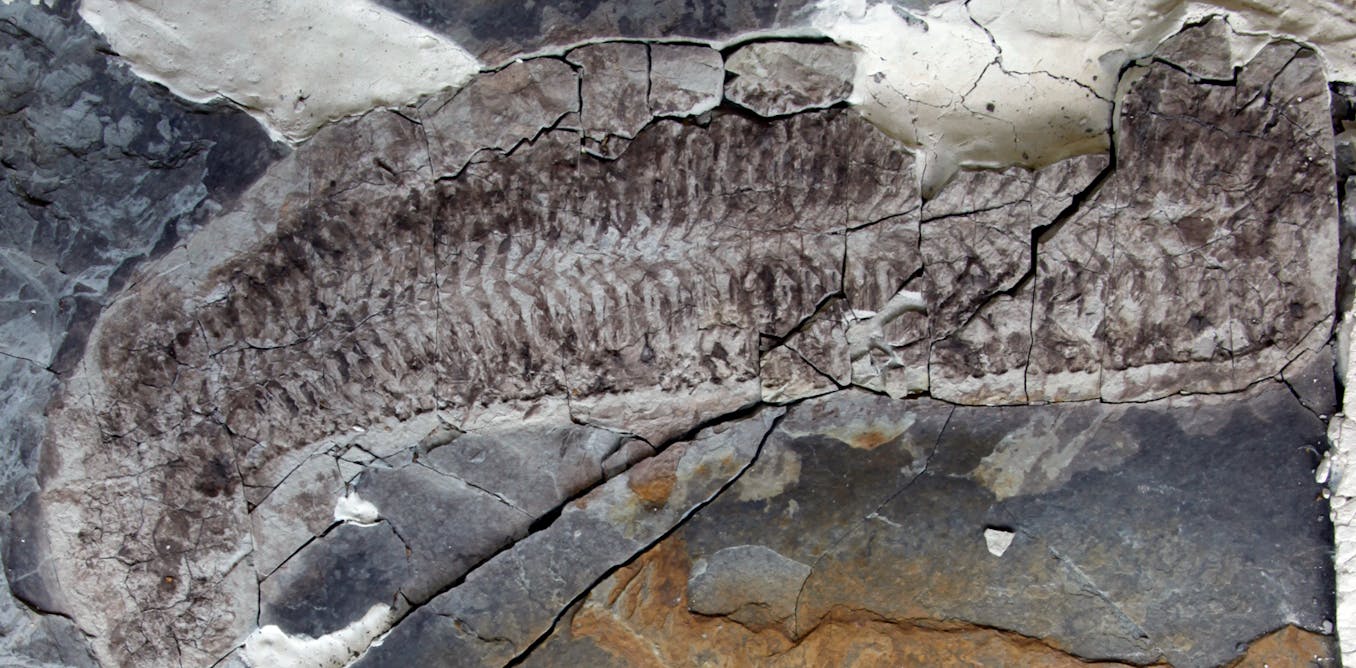A fossilised creature found in a South African roadside quarry 25 years ago has finally got an official name. The small, segmented, crustacean-like creature, dated to 444 million years ago, can now be introduced as Keurbos susanae. It belongs to the arthropod group of animals, which accounts for about 84% of all known species that exist today, including insects, spiders and crabs.
Palaeontologist Sarah Gabbott explains what’s so unusual about her discovery, which she named as part of the process of describing it scientifically.
What can you tell us about this creature and the environment it lived in?
The fossil is about 50cm long and has 46 almost identical segments. Projecting from each is a delicate, gill-like structure. It would probably have looked like a bit like a horseshoe crab and the gills would have been for absorbing oxygen from the water it lived in. Its insides are exquisitely well-preserved, which is very unusual for fossils – normally only the hard, more decay-resistant external features would be preserved. You can see bundles of muscle fibres that would have powered the limbs, tendons and an internal scaffold structure that gave the animal rigidity.
We think it would have spent most of its life living on, or more likely just above, the seafloor, probably walking and swimming in an undulatory (waving) motion.
It lived in the immediate aftermath of the end Ordovician extinction event more than 440 million years ago, caused by glaciations (the spread of icy conditions) across vast swaths of the planet. This extinction wiped out about 85% of Earth’s species. The marine basin that Keurbos susanae inhabited was probably very cold and at times covered with sea ice.
It was a relatively hostile environment in other ways too. Our analyses of the chemistry of the shales – the sediments on the sea bed where this animal and others lived, now turned to rock – shows that they were deposited under anoxic conditions (that is, there was no oxygen circulating freely in the water). And at times free hydrogen sulfide occurred in the sediment porewaters (the water in tiny spaces between grains of sediment) and even above the seafloor. Not much could live in these conditions and this was critical to this fossil’s amazing preservation.
It meant the carcass was not scavenged by other animals after it died. Also, the chemistry was important in the process whereby the soft tissues, which should usually rot away rapidly, became mineralised quickly after death. This turned the animal’s anatomy to mineral which survived for hundreds of millions of years until it was discovered.
It is preserved “inside out”.
Keurbos susanae is a new genus and species which we are still trying to place among other early arthropods. The fact that its insides are better preserved than its outside makes it difficult to compare with other fossils that are preserved the “other way round”.
How did you find the fossil and what else has been found in that area?
The site is in the Cedarberg mountains, north of Cape Town. To collect fossils in this area you need a permit granted by the Council for Geoscience. Fossil-bearing rocks are protected by law because of their heritage and scientific value.
Fossil hunting in these rocks takes a lot of hard work and patience, splitting open the shales with a hammer and chisel. These shale rocks are what’s left of layers of silt that were once on the sea floor. The fossils here are super rare: you can dig and split shale for days and not find a single fossil! But we know there are some in there because of discoveries made previously.
I found two specimens. The first one is complete but the second one only has the middle part of the body preserved.
In the same rocks we have found some of the earliest vertebrate fossils with mineralised teeth, called conodonts. They were eel shaped and predatory. Also eurypterids (sea scorpions), arthropods with powerful swimming appendages, which would have cruised through the frigid waters. There are also orthocones – a type of chambered cephalopod – like the mollusc fossils called ammonites, which have been found in large numbers, but with a straight shell instead of coiled.
Why has it taken 25 years to describe Keurbos susanae scientifically?
Two reasons really.
First, because of the nature of preservation, where all the insides are perfectly preserved but the outside (the carapace or body covering) is absent, it is just difficult to interpret and compare to other fossils. And secondly because the specimen’s head and legs are missing and these are key characteristics that palaeontologists would use to help them to understand the evolutionary relationships of such fossils.
If more specimens were to be found, with their heads and legs, we could be more certain about where this fossil fitted in the scheme of life. But the site where I found it has been covered in a lot of rock from quarrying activity. So we decided to describe what we had in the meantime, and not wait for more examples.
The fossil’s name, Keurbos susanae, refers to the place where I found it and to my mother, Sue, who encouraged me to follow a career that made me happy, whatever that might be.
![]()
Sarah Gabbott receives funding from Natural Environmental Research Council; National Geographic. She is affiliated with Green Circle Nature Regeneration CIC a not for profit Environmental Community Interest Company in the UK



